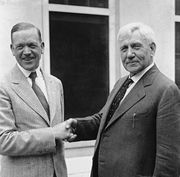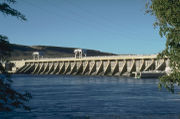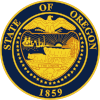Charles L. McNary
| Charles L. McNary | |
 Portrait by Henrique Medina |
|
|
3rd United States Senate Minority Leader
|
|
|---|---|
| In office 1933–1944 |
|
| Preceded by | Joseph T. Robinson |
| Succeeded by | Wallace H. White, Jr. |
|
United States Senator
from Oregon |
|
| In office May 29, 1917 – November 5, 1918 |
|
| Preceded by | Harry Lane |
| Succeeded by | Frederick W. Mulkey |
|
United States Senator
from Oregon |
|
| In office December 18, 1918 – February 25, 1944 |
|
| Preceded by | Frederick W. Mulkey |
| Succeeded by | Guy Cordon |
|
|
|
| Born | June 12, 1874 Salem, Oregon |
| Died | February 25, 1944 (aged 69) Fort Lauderdale, Florida |
| Nationality | American |
| Political party | Republican |
| Spouse(s) | Jessie Breyman Cornelia Morton McNary |
| Alma mater | Stanford University |
| Profession | Attorney |
| Religion | Baptist |
Charles Linza McNary (June 12, 1874 – February 25, 1944) was a United States Republican politician from Oregon. He served in the Senate from 1917 to 1944, and was Senate Minority Leader from 1933 to 1944. In the Senate, McNary helped to pass legislation that led to the construction of Bonneville Dam on the Columbia River, and worked on agricultural and forestry issues. He also supported many of the New Deal programs at the beginning of the Great Depression. Until Mark O. Hatfield surpassed his mark in 1993, he was Oregon’s longest serving senator.
McNary was the Republican vice presidential candidate in 1940, on the ticket with presidential candidate Wendell Willkie. They lost to the Democratic ticket, composed of Franklin D. Roosevelt, who was running for his third term as president, paired with Henry A. Wallace. McNary was a justice of the Oregon Supreme Court from 1913 to 1915 and was dean of Willamette University College of Law, in his hometown of Salem, from 1908 to 1913. Before that, he was a deputy district attorney under his brother John Hugh McNary, who later became a federal judge for the District of Oregon.
McNary died in office after unsuccessful surgery on a brain tumor. Oregon held a state funeral for him, during which his body lay in state at the Oregon State Capitol in Salem. McNary Dam, McNary Field, and McNary High School in Oregon are named in his honor.
Contents |
Early life
McNary was born on his maternal grandfather's family farm north of Salem on June 12, 1874.[1][2] He was the ninth of ten children, and the third son, born to Hugh Linza McNary and Margaret McNary (née Claggett).[2] When the two married in 1860, Hugh McNary's father-in-law gave him a 112-acre (0.45 km2) farm in what is now the city of Keizer.[2] Charles McNary's paternal grandfather, James McNary, immigrated to the Oregon Country from Kentucky in 1845, while his maternal grandfather and namesake, Charles Claggett, immigrated from Missouri in 1852.[2][3]
McNary's father helped on the family farm, then taught school for a few years before returning to farming near Salem.[4] When McNary's mother died in 1878, his father moved the family to Salem where he bought a general merchandise store after being unable to run the family farm because of declining health.[2] Charles, known as Tot, began his education at a one-room school in Keizer and later attended Central School in Salem, living on North Commercial Street.[2] Hugh McNary died in 1883, which made Charles an orphan at the age of nine.[1]
Nina McNary became the head of the household, while other siblings took jobs in order to provide for the family.[5] As a boy, Charles worked as a paperboy, in an orchard, and at other farming tasks.[5] He met Herbert Hoover, a future U.S. president, who moved to Salem in 1888.[5] He later worked in the county recorder's office for his brother John Hugh McNary, who had been elected as county recorder in 1890, and for a short time attended the Capital Business College.[5] After leaving that school, he enrolled in college preparatory classes at Willamette University, with an eye towards attending Stanford University or the University of California.[5] During this time he met Jessie Breyman, whom he began dating, at a social club he helped start.[5] Another member of the club was Oswald West, a future governor of Oregon.[5]
Legal career
In the autumn of 1896, McNary moved to California to attend Stanford, where he studied law, economics, science, and history while working as a waiter to pay for his housing.[3][6] He left Stanford and returned to Oregon in 1897 after his family asked him to come home.[7] Back in Salem, he read law under the supervision of his brother John and Samuel L. Hayden, and passed the bar in 1898.[8] The brothers practiced law together in Salem as McNary & McNary, while John also served as deputy district attorney for Marion County.[7] At this time, Charles bought the old family farm and returned it to the family.[7] From 1909 to 1911 he served as president of the Salem Board of Trade, and in 1909 helped to organize the Salem Fruit Union, an agricultural association.[9]

While still partnered with his brother, McNary began teaching property law at Willamette University College of Law in the spring of 1899 and courting Jessie Breyman.[7] In 1908, he was hired as its dean to replace John W. Reynolds.[7] As dean, he worked to enlarge the school and secure additional classroom space.[7] He recruited prominent local attorneys to serve on the faculty and increased the size of the school from four graduates in 1908 to 36 in 1913, his last year as dean.[7] In his drive to make Willamette's law school one of the top programs on the West Coast, he had it re-located from leased space in office buildings to the university campus.[7]
On November 19, 1902, he married Breyman, the daughter of successful Salem businessman Eugene Breyman.[7] Jessie died on July 3, 1918, in an automobile accident south of Newberg on her way home to Salem.[10] She had been in Oregon to attend the funeral of her mother and was returning from Portland in the Boise family's car when it flipped and crushed her.[10] McNary spent several days in Oregon for her funeral and then returned to Washington.[10] Charles and Jessie had no children.
Political career

McNary first held public office in 1892 when he became Marion County's deputy recorder, remaining in the position until 1896.[3] In 1904 he managed his brother John's successful campaign to be district attorney for the third judicial district of Oregon.[7] John then appointed his younger brother as his deputy, and Charles served as deputy until 1911.[6][7]
Steve Neal, McNary's biographer, describes McNary as a progressive who stuck with the Republican party in 1910 even when many progressives left the party in favor of West, a Democrat.[7] McNary backed the Progressive Era reforms—the initiative, recall, referendum, primary elections, and the direct election of U.S. senators— of Oregonian William S. U'Ren, and he was an early supporter of public rather than private power companies.[11] After West won the election, he chose McNary to be special legal counsel to Oregon's railroad commission; the appointee used the position to urge lower passenger and freight rates.[11] Meanwhile, McNary maintained friendly relations with both progressive and conservative factions of the Oregon Republicans as well as with West.[7]
In 1913 West appointed McNary to the Oregon Supreme Court to fill a new position created by the legislature's expansion of the court from five justices to seven.[12] The youngest of the justices at age 38, McNary left the law school and private practice behind.[13] He quickly "established himself as a judicial activist and strong advocate of progressive reform".[14] A supporter of organized labor, McNary "consistently defended the rights of injured workers and was not hesitant about using the bench as an instrument for social change"[15] such as an eight-hour work day for public employees.[15] Trade unions supported McNary throughout his political career.[15]
In 1914, the court moved into the new Oregon Supreme Court Building and McNary filed to run for a full-six year term on the bench.[13] At that time the office was partisan, and McNary lost the Republican primary by a single vote to Henry L. Benson after several recounts and the discovery of uncounted ballots.[13] After his defeat, he served the remainder of his partial term and left the court in 1915.[16] On July 8, 1916, after a close multi-ballot contest among several contenders, the Republican State Committee members elected McNary to be their chairperson.[17] He was seen as someone who could unify the progressive and conservative wings of the party in Oregon.[17]
National politics
As chairman of the state's Republican Party, McNary campaigned to get Republican presidential nominee Charles Evans Hughes elected in the November 1916 general election.[18] Hughes, a former U.S. Supreme Court justice and future chief justice, carried Oregon but lost the presidency to incumbent Woodrow Wilson.[18] When U.S. Senator Harry Lane died in office on May 23, 1917, it created an opportunity for McNary to redeem himself after his failed bid for election to the Oregon Supreme Court.[18][19] McNary was among several possible successors considered by Oregon Governor James Withycombe.[20] The governor preferred someone who supported national women's suffrage and prohibition, and he shared with McNary an interest in farming.[20] Furthermore, McNary supporters argued that both progressive and conservative factions of the Republican Party would accept McNary and that their unity would give the party the best chance of retaining the Senate seat in the next election.[20] Withycombe appointed McNary to the unexpired term on May 29.[20]

After resigning as state party chairman, McNary prepared to campaign for a full term in the Senate. He faced Speaker of the Oregon House of Representatives Robert N. Stanfield in the May 1918 Republican primary.[10] McNary defeated Stanfield 52,546 to 30,999.[10] In the November general election he defeated friend and former governor Oswald West 82,360 to 64,303 to win a full six-year term in the Senate.[10] Meanwhile, Frederick W. Mulkey won the election to replace McNary and finish Lane's original term that would end in January 1919, and Mulkey took office on November 6, 1918, replacing McNary in that seat.[10]
Shortly after taking office, Mulkey resigned the seat effective December 17, 1918, and McNary was then re-appointed to the Senate on December 12, 1918, and took office on December 18, instead of taking office in January when his term he was elected to would have commenced.[6][21] Mulkey resigned in order to give McNary a slight seniority edge over other new members of the Senate.[10][21] In 1920, former adversary Stanfield defeated incumbent Democrat George Earle Chamberlain for Oregon's other Senate seat, making McNary the state's senior Senator.[22] McNary won re-election four times, in 1924, 1930, 1936, and 1942, serving in Washington, D.C., until his death in 1944.
Senate years
After World War I, U.S. President Woodrow Wilson sought Senate approval of the Treaty of Versailles. Because the treaty included provisions for establishing and joining the League of Nations, one of Wilson's Fourteen Points, Republicans opposed it.[23][24] Going against much of his party, McNary, part of a group of senators known as "reservationists", proposed minor changes but supported the United States entry into the League.[23] Ultimately, the Senate never ratified the Treaty of Versailles, and the United States never joined the League of Nations.[24]
One of the prime opponents of Wilson and the League of Nations was Senate Majority Leader Henry Cabot Lodge.[22] After McNary demonstrated his skill in the debate over the League, Lodge took him under his wing and the two formed a longtime friendship.[22] This friendship helped McNary secure favorable committee assignments and ushered him into the inner power circle of the Senate.[22] Early in his career he served as chairman of the Irrigation and Reclamation of Arid Lands Committee, and as a member of the Agriculture and Forestry Committee.[6] In 1922, President Warren G. Harding asked McNary to be the Secretary of the Interior to replace Albert B. Fall because of Fall's involvement in the ongoing Teapot Dome scandal.[22] McNary declined, preferring to stay in the Senate.[22]

In 1933, McNary was selected as the Senate Minority Leader by fellow Republicans when the Senate was under Democratic control during the New Deal era.[25] He remained minority leader for the rest of his time in office.[6] As minority leader he "hovered most of the time on the periphery of the Republican left",[1] and he opposed disciplining Republican senators who supported President Franklin Roosevelt.[25] He supported many of the New Deal programs at the beginning of Roosevelt’s presidency. As World War II approached, he favored "all aid to England and France short of war".[1] He voted to keep an arms embargo in place, but voted for the lend-lease agreement with the British in 1941 and to re-instate Selective Service in 1940 in preparation for military conscription of civilian men.[3]
As early as the 1920s, McNary supported the development of federal hydroelectric power dams,[1] and in 1933 he introduced legislation that led to the building of the Grand Coulee and Bonneville dams on the Columbia as public works projects.[26] He voted in favor of the United States joining the World Court in 1926. He favored buying more National Forest lands, re-forestation, fire protection for forests via the Clarke-McNary Act, and farm support. Although vetoed by President Coolidge, the McNary-Haugen Farm Relief Bill was the forerunner of the farm-related parts of the New Deal.[27]
Vice presidential nomination
In 1940, he was the Republican vice presidential nominee,[28] a western farm leader chosen to balance the ticket of presidential nominee Wendell Willkie, a pro-business leader from the east.[27] The two men differed on many issues. Writing for Life magazine shortly before the general election in 1940, Richard L. Neuberger said, "Whether as Vice President of the U.S. Charley McNary can keep on endorsing Government-power projects, isolation, high tariffs and huge outlays for farm relief under a President who believes in none of these things remains to be seen."[1] McNary's acceptance speech re-iterated his support for the Tennessee Valley Authority,[29] a federally owned power-producing corporation that Willkie as "the head of a far-flung [private] utilities empire" had opposed.[1] During the campaign, McNary promoted farming issues and criticized foreign trade agreements that he said had "closed European markets to our grain, meat, fruits and fiber."[30] The Willkie–McNary ticket lost the Electoral College to President Roosevelt and Henry A. Wallace, 449 to 82.
Family and legacy
On December 29, 1923, McNary married for the second time, to Cornelia Woodburn Morton. He met Morton at a dinner party during World War I, in her hometown of Washington, D.C.[31] Before the marriage, she worked as his private secretary.[31] As with his first marriage, his second did not produce children, but Charles and Cornelia adopted a daughter named Charlotte in 1935.[1]
In 1926, McNary built a new $6,000 ranch-style house, which he designed himself, along two creeks on his farm north of Salem.[31] His estate, called "Fir Cone", featured a putting green, rose garden, tennis court, fishpond, and arboretum, and more than 250 acres (1.0 km2) of trees.[32] Fir Cone was described as Oregon's Monticello by later Senator Richard L. Neuberger, as it hosted many meetings with politicians from the national stage.[31] The farm included 110 acres (0.45 km2) of nut and fruit orchards, through which McNary helped establish the filbert industry in Oregon[7][33] and on which he developed the Imperial prune.[1]
After complaining of headaches and suffering slurred speech beginning in early 1943, McNary went to the Bethesda, Maryland, Naval Hospital on November 8, 1943, where doctors diagnosed a malignant brain tumor.[34] They removed it that week, and McNary was released from the hospital on December 2, but the cancer had already spread to other parts of his body.[34] He and his family departed for Fort Lauderdale, Florida, to spend the winter.[34] He partly recovered from the surgery, but by February 24, 1944, when he was re-elected as Republican senate leader, he was comatose.[34] Charles L. McNary died February 25, 1944, in Fort Lauderdale,[35] and was buried in Belcrest Memorial Cemetery in Salem. He was given a state funeral, during which his body lay in state in the chamber of the Oregon House of Representatives at the Oregon State Capitol in Salem.[34]
McNary's running-mate Willkie died six months later. It was the only time both members of a major party presidential ticket died during the term for which they sought election. At the time of his death, McNary held the record for longest-serving senator from Oregon, a record he kept until 1993 when Mark O. Hatfield surpassed his mark of 9,726 days in office.[36]
McNary Dam on the Columbia River between Oregon and Washington is named after him, as is McNary Field, Salem's airport.[32] McNary High School in Keizer and McNary Residence Hall at Oregon State University are also named in his honor.[32]
References
- ↑ 1.0 1.1 1.2 1.3 1.4 1.5 1.6 1.7 1.8 Neuberger, Richard L. (1940-08-12). "McNary of Fir Cone". Life (Time, Inc.): pp. 76–84. http://books.google.com/books?id=00UEAAAAMBAJ&pg=PA76&lpg=PA76&dq=McNary+of+Fir+Cone&source=bl&ots=H1nKHOzU1k&sig=V2Mz7IVag10zd49Z5I1Ck7fEYog&hl=en&ei=9W3aSu6RG4_4sgOUrJSxCQ&sa=X&oi=book_result&ct=result&resnum=1&ved=0CAsQ6AEwAA#v=onepage&q=McNary%20of%20Fir%20Cone&f=false. Retrieved 2009-10-17.
- ↑ 2.0 2.1 2.2 2.3 2.4 2.5 Neal, Steve (1985). McNary of Oregon: A Political Biography. Portland, Oregon: Western Imprints. pp. 1–2. ISBN 0875951732. OCLC 12214557.
- ↑ 3.0 3.1 3.2 3.3 Oregon Biographical Dictionary. St. Clair Shores, Michigan: Somerset Publishers, Inc.. 1999. pp. 130–134. ISBN 0-403-09841-6.
- ↑ Gaston, Joseph (1912). The centennial history of Oregon, 1811–1912, Volume 4. Chicago: The S.J. Clarke Publishing Company. p. 389. http://books.google.com/?id=lL9YAAAAMAAJ&pg=PA389&lpg=PA389&dq=salem+fruit+union+mcnary&q=salem%20fruit%20union%20mcnary. Retrieved 2009-10-16.
- ↑ 5.0 5.1 5.2 5.3 5.4 5.5 5.6 Neal, pp. 3–6.
- ↑ 6.0 6.1 6.2 6.3 6.4 "McNary, Charles Linza". Biographical Directory of the United States Congress. United States Congress. http://bioguide.congress.gov/scripts/biodisplay.pl?index=M000583. Retrieved 2007-02-03.
- ↑ 7.00 7.01 7.02 7.03 7.04 7.05 7.06 7.07 7.08 7.09 7.10 7.11 7.12 7.13 Neal, pp. 9–13.
- ↑ Colmer, Montagu; Charles Erskine Scott Wood (1910). History of the Bench and Bar of Oregon. Portland, Or.: Historical Pub. Co.. p. 180.
- ↑ Neal, pp. 12–13
- ↑ 10.0 10.1 10.2 10.3 10.4 10.5 10.6 10.7 Neal, pp. 39–50.
- ↑ 11.0 11.1 Neal, p. 13
- ↑ Neal, p. 17
- ↑ 13.0 13.1 13.2 Neal, pp. 17–24.
- ↑ Neal, p. 18
- ↑ 15.0 15.1 15.2 Neal, p. 19
- ↑ Neal, p. 24
- ↑ 17.0 17.1 Neal, p. 30
- ↑ 18.0 18.1 18.2 Neal, pp. 29–38.
- ↑ "Harry Lane". Biographical Directory of the United States Congress. United States Congress. http://bioguide.congress.gov/scripts/biodisplay.pl?index=L000059. Retrieved 2008-11-26.
- ↑ 20.0 20.1 20.2 20.3 Neal, pp. 32–33
- ↑ 21.0 21.1 "Frederick W. Mulkey Was Twice Elected to the United States Senate from Oregon" (subscription required). The New York Times. 1924-05-06. http://0-proquest.umi.com.catalog.multcolib.org/pqdweb?index=48&did=104250558&SrchMode=1&sid=3&Fmt=10&VInst=PROD&VType=PQD&RQT=309&VName=HNP&TS=1255732833&clientId=11892. Retrieved 2009-10-16.
- ↑ 22.0 22.1 22.2 22.3 22.4 22.5 Neal, pp. 61–70.
- ↑ 23.0 23.1 Neal, pp. 50–59.
- ↑ 24.0 24.1 Egerton, George W. (December 1978). "Britain and the 'Great Betrayal': Anglo-American Relations and the Struggle for United States Ratification of the Treaty of Versailles, 1919-1920". The Historical Journal (Cambridge University Press) 21 (4): 891, 909–911. ISSN 0018-246X. http://www.jstor.org/stable/2638973.
- ↑ 25.0 25.1 Associated Press (1933-03-06). "Senate Democrats to Organize Today" (subscription required). The New York Times. http://0-proquest.umi.com.catalog.multcolib.org/pqdweb?index=104&did=104293550&SrchMode=1&sid=1&Fmt=10&VInst=PROD&VType=PQD&RQT=309&VName=HNP&TS=1255916449&clientId=11892. Retrieved 2009-10-18.
- ↑ Dick, Wesley Arden (Autumn - Winter, 1989). "When Dams Weren't Damned: The Public Power Crusade and Visions of the Good Life in the Pacific Northwest in the 1930s" (subscription required). Environmental Review (Forest History Society and American Society for Environmental History) 13 (3/4): 122. http://0-www.jstor.org.catalog.multcolib.org/stable/3984393?seq=10. Retrieved 2008-10-05.
- ↑ 27.0 27.1 Catledge, Turner (1940-06-29). "Senator Drafted: New Party Rulers Pick Veteran Farm Leader to Balance Ticket" (subscription required). The New York Times. http://0-proquest.umi.com.catalog.multcolib.org/pqdweb?index=22&did=93983700&SrchMode=1&sid=6&Fmt=10&VInst=PROD&VType=PQD&RQT=309&VName=HNP&TS=1255735779&clientId=11892. Retrieved 2009-10-16.
- ↑ Neuberger, Richard L. (1940-07-07). "M'Nary Is Strong in the Northwest" (subscription required). The New York Times. http://0-proquest.umi.com.catalog.multcolib.org/pqdweb?index=30&did=112747100&SrchMode=1&sid=6&Fmt=10&VInst=PROD&VType=PQD&RQT=309&VName=HNP&TS=1255736101&clientId=11892. Retrieved 2009-10-16.
- ↑ "M'Nary's Acceptance of the Vice Presidential Nomination" (subscription required). The New York Times. 1940-08-28. http://0-proquest.umi.com.catalog.multcolib.org/pqdweb?index=57&did=113378856&SrchMode=1&sid=2&Fmt=10&VInst=PROD&VType=PQD&RQT=309&VName=HNP&TS=1255926511&clientId=11892. Retrieved 2009-10-18.
- ↑ "Hull 'Double Talk' Scored by M'Nary" (subscription required). The New York Times. 1940-10-06. http://0-proquest.umi.com.catalog.multcolib.org/pqdweb?index=93&did=94004072&SrchMode=1&sid=2&Fmt=10&VInst=PROD&VType=PQD&RQT=309&VName=HNP&TS=1255752824&clientId=11892. Retrieved 2009-10-16.
- ↑ 31.0 31.1 31.2 31.3 Neal, pp. 85–88.
- ↑ 32.0 32.1 32.2 Terry, John (October 20, 2002). "Oregon's Trails; Oregon's Sen. McNary was a tree hugger for his time". The Oregonian: p. A22.
- ↑ The McNary Family (Keizertimes online reprint, with self-published author's permission, of material from Looking Back–People and Places in the Early Keizer Area, 1981 ed.). Anne Lossner. http://www.keizertimes.com/news/story.cfm?story_no=7655. Retrieved 2007-09-06.
- ↑ 34.0 34.1 34.2 34.3 34.4 Neal, pp. 233–235.
- ↑ "Senator M'Nary Dies in Florida" (subscription required). The New York Times. 1944-02-26. http://0-proquest.umi.com.catalog.multcolib.org/pqdweb?index=17&did=85148918&SrchMode=1&sid=5&Fmt=10&VInst=PROD&VType=PQD&RQT=309&VName=HNP&TS=1255733447&clientId=11892. Retrieved 2009-10-16.
- ↑ Ultich, Roberta (August 26, 1993). "Hatfield chalks up yet another mark". The Oregonian: p. D1.
External links
 Media related to Charles McNary at Wikimedia Commons
Media related to Charles McNary at Wikimedia Commons- Senate Portrait
- Salem Online History: Charles McNary
- Letter to McNary from President Hoover
- Memorial services held in the House of representatives and Senate of the United States, together with remarks presented in eulogy of Charles Linza McNary, late a senator from Oregon. Seventy-eighth Congress, second session.
- Historic images of Charles McNary from Salem Public Library
- "Charley Mac". Time Magazine. 1944-03-06. http://www.time.com/time/magazine/article/0,9171,774801,00.html. Retrieved 2008-08-10.
- Supreme Court Justices of Oregon
- Governors of Oregon
- Harry Lane
| Legal offices | ||
|---|---|---|
| Preceded by None (new seat) |
Associate Justice of the Oregon Supreme Court 1913–1915 |
Succeeded by Henry L. Benson |
| United States Senate | ||
| Preceded by Harry Lane |
United States Senator (Class 2) from Oregon 1917–1918 Served alongside: George E. Chamberlain |
Succeeded by Frederick W. Mulkey |
| Preceded by Frederick W. Mulkey |
United States Senator (Class 2) from Oregon 1919–1944 Served alongside: George E. Chamberlain, Robert N. Stanfield, Frederick Steiwer, Alfred Evan Reames, Alexander G. Barry, Rufus C. Holman |
Succeeded by Guy Cordon |
| Party political offices | ||
| Preceded by James E. Watson |
Senate Republican Leader 1933–1944 |
Succeeded by Wallace H. White, Jr. |
| Preceded by Frank Knox |
Republican Party Vice Presidential candidate 1940 |
Succeeded by John W. Bricker |
| Academic offices | ||
| Preceded by John W. Reynolds |
Dean of Willamette University College of Law 1908–1913 |
Succeeded by Isaac Homer Van Winkle |
|
||||||||||
|
|||||||
|
|||||||
|
|||||||||||||||||||||||||
|
||||||||||||||||||||

